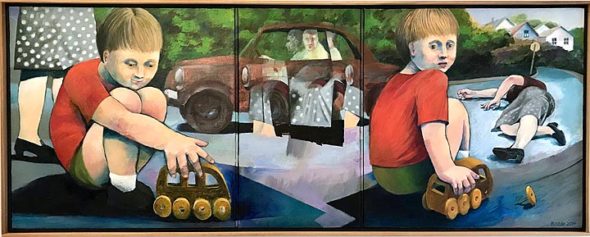Artist’s work graces magazine cover
- Published: July 4, 2019
The American Psychologist magazine, published by the American Psychological Association, recently featured the work of villager and artist David Battle on the cover of its May-June issue. The publication features the work of artists on each of its issues.
Battle’s work, “Trauma Reshaped,” is a triptych painting that tells the story of a child at play and a seemingly tragic accident — but what is actually happening on the canvas is open to interpretation by the viewer. In an essay penned by Art Co-Editor Kate F. Hays, several interpretations are suggested: “Where is the trauma, and how has it been shaped or reshaped? … Did the accident truly happen, or was it a projection of the child’s fears or his wishes? … His gaze at the viewer may prompt one to try to understand his experience.”
The painting, which hangs in Battle’s Yellow Springs home, had its beginnings in a sketch he drew one morning outside of the Emporium. Viewing a group of parents talking as their children played on the sidewalk, he noted the different “worlds” in which the adults and children seemed to co-exist in a single moment, and set the image to paper. The sketch inspired a deeper look into that moment, as Hays writes: “What kind of traumatic situation might move this static moment and the two different worlds of parents and children into an active event?”
Battle answered this question with “Trauma Reshaped.” The viewer follows the motion of the adult figure, seen from the vantage point of a child at play, as she moves across the three canvases, from left to right. The center panel of the work is its ultimate focal point, and where the crux of the story, however the viewer interprets it, takes place. As Battle was quoted in the magazine as saying, “I struggled to represent the overpowering noise, distortions of time and the collision of the two worlds from harmony to destruction.”
Battle is well known as the artist responsible for 40 years of covers for The Antioch Review, as well as his design for the 1972 Peace Corps stamp, on display in the Smithsonian’s National Postal Museum. “Trauma Reshaped” will be seen by 75,000 subscribers to American Psychologist, which was established in 1946 and publishes nine times per year. For more information, visit http://www.apa.org/pubs/journals/amp.
The Yellow Springs News encourages respectful discussion of this article.
You must login to post a comment.
Don't have a login? Register for a free YSNews.com account.














No comments yet for this article.